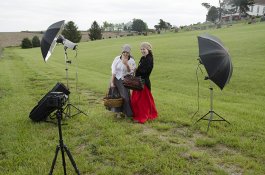Hi,
I understand that I can figure this out using trial and error, however I wanted to know what your thoughts are since I'm new film photography.
I have a Nikon EM, and an SB E flash, it doesn't TTL flash (it's an automatic flash but not TTL - I don't quite understand how it works since I use a different setup most of the time and I haven't spent enough time with EM). The camera syncs with the flash at 1/90th of a second.
Hypothetically, it's a sunny day and a landscape you want in focus calls for an f16 aperture and a shutter speed of 1/400 (using a 400 ISO film) and most likely this is what the camera will choose for you anyways (Nikon EM works on Aperture priority only), you set your aperture on 16 (to get the background in focus), however your child is under the shade of a tree and you mount your flash to get his face well lit. Knowing that the camera will choose 1/90 for you, won't that overexpose your background (too much ambient light)? If you change your ISO to (say) 1600, won't that underexpose your subject (child)?
What do you think?
Thanks!
Saif.
PS: I understand that I have a lot of limitations here, I'm just wondering if it can be done with this setup.
I understand that I can figure this out using trial and error, however I wanted to know what your thoughts are since I'm new film photography.
I have a Nikon EM, and an SB E flash, it doesn't TTL flash (it's an automatic flash but not TTL - I don't quite understand how it works since I use a different setup most of the time and I haven't spent enough time with EM). The camera syncs with the flash at 1/90th of a second.
Hypothetically, it's a sunny day and a landscape you want in focus calls for an f16 aperture and a shutter speed of 1/400 (using a 400 ISO film) and most likely this is what the camera will choose for you anyways (Nikon EM works on Aperture priority only), you set your aperture on 16 (to get the background in focus), however your child is under the shade of a tree and you mount your flash to get his face well lit. Knowing that the camera will choose 1/90 for you, won't that overexpose your background (too much ambient light)? If you change your ISO to (say) 1600, won't that underexpose your subject (child)?
What do you think?
Thanks!
Saif.
PS: I understand that I have a lot of limitations here, I'm just wondering if it can be done with this setup.




